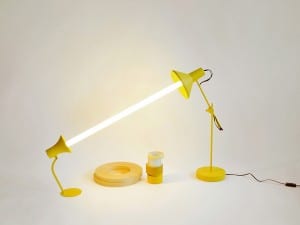Over the last 20 years, we’ve seen big changes in the way our devices look and feel. In the late 1990s and early 2000s, there were an array of different types, shapes and sizes available – Juno‘s famous hamburger phone being one of them. But when the iPhone launched in 2007, Steve Jobs heralded a new era defined by minimal, intuitive aesthetics. Smartphones became sleek and rectangular, available mainly in black, silver and white, replacing predecessors that flipped, slid and twisted. The Fusion of Design and Technology is the theme of this year’s Design Shenzhen, running from 21 – 24 March. It’s the second edition of the fair, showcasing projects by leading global furniture companies, architectural firms, tech giants and multi-disciplinary creatives. With Royal Academy of Arts and Foster + Partners on the list of keynote speakers, Design Shenzhen has established itself as a hub for innovation. Here, we round up our highlights.

The process of innovation involves looking around, gathering information, and using your findings to create something new. But it also requires us to look inward, and Design Shenzhen doesn’t shy away from doing so. Notable speakers at this year’s event include Satoshi Ohashi, Director of Zaha Hadid Architects, and renowned architects and designers Aldo Cibic and Steve Leung. Besides an array of international names and brands, the fair turns attention to local creativity. It features a multitude of Chinese practices, such as Archimedes, which brings innovative seating solutions; the lifestyle brand DakHaan; and carpets and wallpapers produced by TAT MING. Additionally, the 3D printing group LINKUNIT showcases unique objects produced in-situ. Here, audiences can explore the infinite possibilities afforded by rapid manufacturing technologies. Shenzhen’s display is a tribute to ideas and a celebration of what happens when traditional craftsmanship and technology merge.
Another notable exhibition is WellConnect, dedicated to the future of modern living across home, public spaces and work environments. 2024’s display, Nest, presents a serene space that prioritises comfort, relaxation and safety. Visitors will discover all-new architectural solutions, as well as data measurement technologies and furniture designs. The focus here is on experience, with light being harnessed to create a sensory environment. It’s a place to discover what happens when wellness and science intersect. This is further expressed in DAST Technology and Art Application Special Exhibition, a venture that blends Design, Art Social and Tech, into a unified entity, activating a model for commercial real estate.

The idea of mindfulness carries throughout the fair, and culminates in The Good Design Awards. The initiative, originally founded in Japan, debuts in Shenzhen for 2024. Curated by industrial designer Xiaoxi Shi, it brings together products designed to enrich lives, with longevity in mind. This year’s exhibition highlights MEIZU 20 INFINITY, an emblematic Chinese design clinching the G-Mark Award in 2023. The show encourages visitors to see overlooked everyday items – ceramics, cutlery, furniture and glassware – from different perspectives. Sustainability is also at the heart of the The Rural Futures Award, which recognises eco-conscious design choices. Over three categories, winners are selected for constructions that reduce resource loss; show new possibilities for redevelopment; and integrate sustainable measures.

Design Shenzhen | 21-24 March
designshanghai.com/design-shenzhen
Image credits:
1. Design Shenzhen – DAST
2. Design Shenzhen 2024 Exhibitor – FULI
3. Design Shenzhen 2024 Exhibitor – CERAWEI
4. Design Shenzhen





